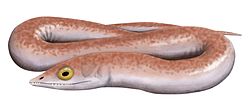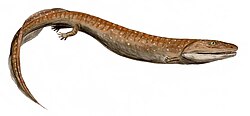Description
Hyneria was a large fish. H. lindae is estimated around 2.5–3 metres (8.2–9.8 ft) in total length. [3] [4] An isolated cleithrum AM 6545 likely belongs to an individual of at least 2.7 metres (8.9 ft) in length. [2] The largest complete jaw reaches 38 centimetres (15 in), but there is much larger fragment possibly from a jaw about twice that length, although that specimen may belong to a rhizodont instead. [5] Assuming this jaw fragment does pertain to Hyneria, and assuming proportions similar to more complete tristichopterids, it suggests H. lindae could possibly reach lengths up to 3.5 metres (11 ft). [6] A second species, H. udlezinye, was once estimated as having a length of between 2 and 4 metres (6.6 and 13.1 ft) before being described. [7] However, the species description estimates that the largest specimen belongs to an animal about 3 metres (9.8 ft). [2] Its skull had heavy, ornamented dermal bones and its lower jaw was relatively long and shallow. The teeth were stout, with those of the premaxilla forming fangs upwards of 5 cm (2 in). [3] [1] Its body was covered by cycloid scales. [1] [8] It had large sensory canals to aid in detection of possible prey, as the freshwater environment it inhabited likely was murky and had low visibility. [8] Adult individuals retained juvenile features (i.e. partially unossified skeletons), suggesting that they were likely neotenic. [9]
This page is based on this
Wikipedia article Text is available under the
CC BY-SA 4.0 license; additional terms may apply.
Images, videos and audio are available under their respective licenses.








